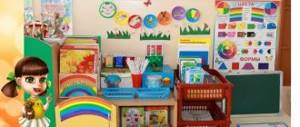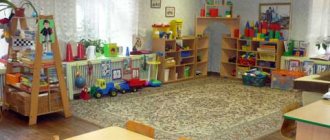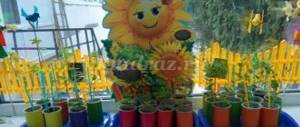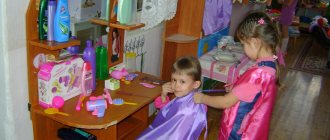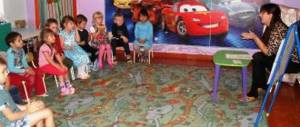Ecological developmental environment in a preschool educational organization
Irina Ostapenko
Ecological developmental environment in a preschool educational organization
«Ecological development environment in preschool educational institutions»
We know that all children are inquisitive and are interested in everything. They look at the world around them with great interest, but they don’t see everything, sometimes they don’t even notice the main thing. And if there is an adult nearby who wonders with them, teaches them not only to look, but also to see, children immediately want to learn even more. By maintaining and developing this interest , a teacher can instill in children many positive personality traits.
To have an idea on this topic, I will briefly expand on it, leading to the concept of ecological-developmental environment .
• Let's start with the fact that ecology is a science that studies the life of organisms in their natural habitat , or environment .
• The environment is the living and non-living things around us.
• For humans, the environment is everything that we see, and much of what is invisible around us.
Combining the three definitions, we can say that a person lives in an ecological environment and is an integral part of it. But since we don’t see much, we often don’t attach importance to the microcosm around us, for one reason or another, we can fill this gap and create a developing ecological environment .
Let's return to the concept of " Ecology "
to understand in which direction to work to create a
developing ecological environment . Let us remember that ecology is a science that studies the environment around us , we are part of this environment - part of ecology . To give children a basic understanding of ecology , it is necessary to create an ecological-developmental environment for in-depth study and presentation of the environment . Since we are talking about a preschool institution , we will create it there.
So, an ecological development environment is designated special places in a kindergarten where natural objects are grouped in a certain way and which can be used in the pedagogical process of environmental education .
In order for the educational space to act as a developing educational environment , during the interaction of its components it must acquire certain properties, such as flexibility, continuity, variability, integration, openness, and an orientation towards joint active communication of all subjects of the educational process .
The ecological and developmental environment in kindergarten should contribute to:
1. cognitive development of the child ;
2. environmental and aesthetic development;
3. improving the child’s health
4. formation of moral qualities
5. formation of environmentally conscious behavior;
6. greening various types of children's activities.
When creating an ecological and developmental environment , it is necessary to take into account the period of study, seasonality, and age of the children.
Naturally, in order for the ecological and developmental environment to contribute to the development of the child , the following components are needed:
1. corners in groups (experimental, nature, exhibition)
2. mini laboratory (materials for experimentation, natural material)
3. library (educational literature about nature, literature on animal care, a selection of illustrations from the life of animals, plants, seasonal changes, as well as video and audio materials)
4. playgrounds designed by each group for organizing environmental holidays , excursions and games
5. vegetable garden, flower garden (flowers, shrubs, vegetables)
ALL THIS allows us to study the world around us.
To do this, you can use didactic games with natural history content, such as “Summer in the Village”
,
"Pets"
, and others.
And, thanks to the library, we can read and imagine a lot.
FOR EXAMPLE: Find out the names of animals in Africa, Asia, South and North America, Australia, what they eat, their habitat ,
But by holding cleanup days at the site, children develop labor skills and abilities in general. Preserving "Our Home"
- nature is pure because we are part of this nature - this creates a love for nature, and a complete understanding of work, as well as respect for the work of adults.
In the process of joint work, as well as collective work with natural materials, children develop social and communication skills.
We know that nature surrounds a child from childhood. Children, due to their curiosity, constantly observe nature on the street, in the country, in the park, and they develop ecological and aesthetic qualities, the concept of the beauty of nature at different times of the year. Nature gives the child the opportunity to see and realistically understand natural phenomena, to distinguish and feel precipitation. In a preschool organization, you can study nature in an expanded way, going beyond basic information. You can organize and hold a crafts competition “Gifts of Nature”
.
To do this, you need to use natural material. As a rule, it comes in different shapes, colors and sizes. It is these properties that positively influence the development of the sensory system and fine motor skills. And this, in turn, is important for the subsequent comprehensive development of the child’s cognitive sphere, elementary mathematical concepts, as well as all components of the speech system.
Nature for a child will always be a source of new knowledge about various natural phenomena. Only the ability to observe, developed in the process of learning about the world around us, gives rise to the habit of drawing conclusions, fosters the logic of thought, clarity and beauty of speech - these two developments are a single process .
Thanks to ecological and aesthetic development, moral education occurs. Only in preschool age can love for the Motherland, for the native land, for the native nature, for people be formed. As the child grows up, the worldview gradually changes, a person’s ideas and views on the environment change in an unusually complex way. That is why it is important to promptly develop the ecological consciousness of a small personality, to cultivate environmental literacy , through a careful and loving attitude towards human nature on our planet.
In conclusion, I would like to say that the ecological and developmental environment in a preschool institution allows one to receive environmental education . In turn, environmental education allows you to understand nature through observations using the sensory method. Environmental education is associated with the science of ecology , which is associated with a continuous process of learning, self-education , accumulation of experience and personal development .
FOR EXAMPLE, a favorite and very accessible experience with onions, which children themselves plant in different soils, water, grow and watch the growth process. As we know, ONION is a food product. Growing by children of products used directly in the children's diet is used to develop preschoolers' skills in caring for plants, familiarizing themselves with the main vegetable crops and their importance in the diet.
Caring for flowers in a group contributes to the formation of a conscious , environmentally literate attitude of children towards natural objects. They are being introduced to feasible labor in caring for plants and gardens.
Environmental education is aimed at the development and formation of value orientations, norms of behavior and the acquisition of special knowledge on the protection of the natural environment and natural resource management, implemented in environmentally competent activities is Environmental education .
Ecological and developmental subject environment in preschool educational institutions
One of the important conditions for the implementation of an environmental education system in a preschool institution is the correct organization and greening of the developmental subject environment.
K.D. Ushinsky O.
Ecological space is a small area or separate room occupied by natural objects and having a specific functional purpose.
The subject environment becomes developing thanks to the communication of children with adults in this environment.
From the point of view of environmental education, the environment in a preschool institution should contribute to:
- cognitive development of the child (creating conditions for cognitive activity, experimenting with natural materials, systematic observations of objects of living and inanimate nature; developing interest in natural phenomena, searching for answers to questions that interest the child and asking new questions);
- ecological and aesthetic development (attracting the child’s attention to the surrounding natural objects, developing the ability to see the beauty of the natural world, the diversity of its colors and shapes; preference for natural objects over their imitation, artificial objects);
- child health improvement (use of environmentally friendly materials for interior design, toys; assessment of the environmental situation of the territory of a preschool institution; competent design, landscaping of the territory; creation of conditions for excursions, outdoor activities);
- formation of the child’s moral qualities (creating conditions for regular care of living objects and communication with them, cultivating a sense of responsibility, desire and ability to preserve the natural world around them);
-formation of environmentally correct behavior (skills in rational environmental management; caring for animals, plants, environmentally literate behavior in nature);
- ecologization of various types of child activities (conditions for independent play with natural materials, use of natural materials in classes).
Ryzhova N.A. offers some objects that help create an ecological development environment in kindergarten.
Pets' corner.
Living corners (nature corners) are a fairly traditional element of the educational subject environment of preschool institutions in our country. They are very loved by children and play a big role in nurturing an emotional attitude towards living nature, in developing skills in caring for animals and plants, and encourage children to take care of them.
For many years, it was recommended to keep both typical indoor animals (guinea pig, golden hamster, etc.) and wild animals in a living area, which children and adults can bring from a walk to the forest, river, meadow (hedgehog, wild birds, frogs).But from the point of view of environmental education, a person cannot, at his whim, bring wild animals to his home as well as to a kindergarten. On the contrary, we must teach the child to treat animals, birds, etc. with care. The easiest to keep and easily available for purchase are guinea pigs, golden hamsters, white rats, ornamental frogs, budgies, canaries, and turtles. However, if not properly cared for, these animals often get sick and die. If there are conditions, you can purchase rabbits and ornamental chickens.
It is recommended to include, first of all, species that cannot live in a given natural area without human help and that are widely bred at home: canaries, parrots, some types of rodents, etc.
For ease of work, it is recommended to obtain animal and plant passports. Design options can be different: album: a notebook or folder of so-called transparent “files” connected together. In the passport of a plant (animal), you should place a photograph (it can be taken directly in a living corner) or a drawing of this object, indicate the scientific and everyday name of the plant (for example, balsam or Vanka wet) and the animal; if there is interesting information - the origin of the name (for example, why a guinea pig is called a guinea pig, although it has nothing to do with the sea); the homeland of the plant or animal, the conditions in which it lives in nature, environmental features, type of food for animals, features of lifestyle (night, day); connections with other animals and plants.
Some information can be represented as a system of icons. For example, each characteristic of an animal is indicated by a square, and of a plant by a circle.
In the living area, it is necessary to allocate shelves or a cabinet for storing food and caring for plants and animals. Here you can place colorful literature on animal care. A greenhouse in a living corner can serve, first of all, as a place for children to grow food for animals, observe plants, and replenish the diet of preschoolers with vitamins (onions, garlic).
A living corner is a great place to organize observations. When properly organized, a living corner can also contribute to the formation of environmentally literate behavior in children in nature. It is important that each child chooses to care for the plant or animal that he likes best, that is, communicates with living objects at will, and not at the direction of adults.
- It is necessary to introduce children in advance to the characteristics of plants and animals.
- It is also important to explain to preschoolers that “human food” is not suitable for animals; they need to be fed a certain number of times, with a certain amount of food.
- For more emotional contact, children can give names to the inhabitants of the corner. The simplest option they usually follow is to give the animal a human name. However, you can invite the children to first observe the animals, find out their characteristics, and then, based on the results of these observations, give names.
- While leaving. While observing the inhabitants of a living corner, it is necessary to constantly discuss various questions with children, for example: what role does light, water, heat play in the life of animals and plants in a living corner? Why do animals eat different foods? How are domestic animals similar to their relatives in nature and how are they different from them? Why do some people sleep during the day?
Winter Garden.
The winter garden is a relatively traditional element of the environment. It can accommodate various groups of plants. So do individual animals (primarily birds), aquariums, etc. The winter garden traditionally performs health and relaxation functions. Here the child’s cognitive activity is activated, an emotional attitude towards living organisms is fostered, an understanding of their role in our lives, and responsibility for the lives of other beings.
Museums.
Relatively new for kindergartens is the creation of small museums directly in preschool institutions. Landscape-ethnographic mini-museums, nature museums, and art galleries are created as elements of a subject-based development environment. Landscape and ethnographic museums make it possible to acquaint preschoolers with the national and natural features of the region, with issues of the use of nature and the attitude of people towards it in a particular area, with environmental problems using the example of their locality. Nature museums can be created by a team of children, parents and educators. Children proudly present “family exhibits” that they found or created together with their parents (separate collections): beautiful stones, dry branches, growths on trees, abandoned nests (for example, titmouse or wasp), postcards about nature. Museums, as well as environmentally friendly collections, should not contain stuffed animals. The child must communicate with living beings in his immediate environment. To create art galleries, it is rational to use the walls of halls and corridors, including staircases. For the purposes of environmental education, landscapes and “portraits” of animals can be placed here; it is desirable that they be presented in different genres. Mini-museums are also being created in groups: the tree museum, the “Man’s Friend” museum (dogs), etc.
Phytobar.
In recent years, many institutions, especially health-improving ones, have allocated small rooms where children, after procedures and classes in the pool, are offered a set of vitamin teas, infusions of herbs, and fruits. The health value of a herbal bar can be complemented by cognitive and aesthetic ones. The use of various medicinal plants can serve as a starting point for talking with children about the characteristics of these plants, where they grow, rules of collection and protection. Their beauty, attractiveness. It is advisable to select photographs or artistically executed drawings of medicinal plants. Sets of such pictures are hung on the walls of the herbal bar and change depending on the composition of the medicinal mixtures. During the procedures, the teacher draws the children’s attention to the appearance of the plants, their names, features, and tells the legends dedicated to them.
Vegetable garden, garden.
These elements of a developing subject environment can be called traditional for preschool institutions that are deeply involved in familiarization with nature. Traditionally, a vegetable garden is used for a purpose. Developing plant care skills in children. getting to know the main vegetable crops and their importance in our diet. Grown products are often used directly in kindergartens (both for consumption by children and adults, and for animal feed). There are three main types of vegetable gardens:
1. Vegetable garden in the courtyard of a preschool institution.
2. Mini-gardens on the windows.
3. Vegetable gardens in greenhouses, greenhouses.
It is strictly forbidden to eat produce from gardens located near busy highways or in environmentally polluted areas. The second problem of environmental safety, which can be considered using the example of a vegetable garden (orchard), is the need to organize environmentally friendly agriculture: growing plants without the use of pesticides, chemical fertilizers, using biological methods of plant protection, using food waste, compost as fertilizers.
Alpine slide.
The Alpine slide is an unconventional element of the educational subject environment. Variability is manifested in the location of the hill, in the species composition of plants, appearance, and size. The Alpine slide enlivens the environment, attracts children with its unusualness and colorfulness, promotes cognitive interest, develops aesthetic feelings and curiosity in children, and fosters a caring attitude towards living beings. Caring for a slide allows preschoolers to expand their knowledge about plants, their diversity, living conditions, and creates a sense of responsibility in the process of caring for them. A rock garden will help to clearly show the connections between plants and the insects that visit them. The alpine slide usually successfully combines objects of living and inanimate nature, so it can be used to conduct classes in any block of the program. An important feature of alpine slides is that they allow you to place a wide variety of plants in a relatively small area. If the plants are chosen correctly. The rock garden will look attractive in any season of the year - from early spring to late autumn. In addition, from time to time, you can change the species composition of vegetation and create different compositions of plants on the hill.
In urban conditions, difficulties arise with the preservation of the alpine slide, so one of the options is to place it in an ecological room, winter garden or living corner. In this case, you will have to select plants by trial and error, since primarily low-growing indoor plants and succulents (with thick leaves) can survive in indoor conditions. In the premises of a kindergarten, it is also possible to create mini-rock gardens - these are structures in pallets, large concrete containers, on the bottom of which crushed crushed stone, brick or tiles are placed. You can also create a mini rock garden in an aquarium. Sprinkle expanded clay and small stones on the bottom, among which a container with cacti or other small plants will be hidden.
Mini-farms.
Many city children do not have the opportunity to get acquainted with ordinary domestic animals, so some kindergartens that have appropriate conditions create mini-farms on their territory. As a rule, they are a complex of utility rooms and an aviary. Mini-farms not only give children the opportunity to communicate with animals, but also teach them to perform certain duties, the simplest of which is growing the necessary plants in the garden and feeding the animals. Using the example of mini-farm animals, you can discuss with the children a whole range of issues relating to their growth, development, nutrition, benefits for people, etc.
Territory.
Proper design of the territory will allow teachers to effectively organize the process of environmental education. Well-thought-out equipment of the territory allows the teacher to use a regular daily walk to familiarize preschoolers with new material, consolidate what they have learned, cultivate in children an emotional, caring attitude towards the world around them, develop their senses and teach them to see new things in familiar objects. Mini-parks, gardens, flower beds, lawns, small artificial reservoirs with vegetation can be created on the territory, and fragments of various natural and cultural landscapes (forests, meadows, fields) can be recreated. You can select areas for experimentation, where there will always be clean sand, water, and stones. In winter they will be replaced by snow and ice.
Ecological path.
In preschool institutions, ecological paths perform cognitive, developmental, aesthetic, and health-improving functions. Two main types of ecological paths can be distinguished: 1) on the territory of a preschool institution; 2) in natural or close to natural conditions (suburban forest, park, square). Various types of both wild and cultivated plants (trees, shrubs, grasses), mosses, mushrooms on living and dead trees, old stumps, anthills, bird nests in trees, microlandscapes of various natural communities (meadows, forests) are selected as objects of the ecological path. ), flower beds, individual beautifully flowering plants, places where insects regularly gather (for example, soldier beetles), small ponds with plants and animals, vegetable gardens, individual stones that will serve as a refuge for many animals, especially insects, snails, maybe lizards, alpine slide. Human interaction with nature (both positive and negative) can be illustrated by the example of trampled areas, bird feeders, littered ponds outside the kindergarten territory.
Literature
- Ryzhova N.A. Environmental education in kindergarten. M., Karapuz. 2000.
- Nikolaeva S.N. Theory and methods of environmental education for preschool children. M., 2010.
- From birth to school. Approximate general educational program for preschool education / Ed. NOT. Veraksy, T.S. Komarova, M.A. Vasilyeva. – 3rd ed., rev. And additional – M., 2014.
Seminar “Developing ecological environment in preschool educational institutions as a method of education”
The most polluted places are marked in red on the map. You can tell children that there is an environmental map of Russia, the purpose of which is to highlight the most polluted places that are dangerous to life, places of environmental disasters and catastrophes.
Ecological games
Role-playing environmental games are based on modeling the social content of environmental activities, for example the game “City Construction” (its participants play the roles of builders, architects, city residents; the goal of the game is to form the idea that construction can only be carried out if environmental standards and rules are observed) .
Simulation environmental games are based on modeling environmental activities. The game “Ecosystem Reservoir” allows you to trace the role of each component of this system, model the consequences of anthropogenic impact on biocenoses, and the game “Ecological Pyramids” helps to show food chains (the child clearly sees that the violation of one link in the food chain leads to the death of the rest).
Competitive environmental games stimulate the activity of their participants in acquiring and demonstrating environmental knowledge, skills, and abilities. These include: auction competition, marathon competition, KVN, environmental quiz, “Field of Miracles”, etc.
Travel games are widely used in the practice of preschool institutions, in which children, with the help of TSO, get to the North Pole, to the bottom of the ocean, etc.
When working with preschoolers, didactic games are of great importance: “Who lives where”; “Flies, runs, jumps” (about the adaptation of animals to their environment); “Who has which house” (about ecosystems); “Living - nonliving”; “Birds - fish - animals” (for classification according to given characteristics); “What comes first, what comes next” (growth and development of living organisms); “Choose the right road” (about the rules of behavior in nature), etc.
4.Traditional and non-traditional elements of a developing subject ecological environment.
Laboratory - a new element of the developmental subject environment
. It is created to develop children's cognitive interest, interest in research activities and contributes to the formation of a scientific worldview. At the same time, the laboratory is the basis for the child’s specific play activities (work in the laboratory involves turning children into “scientists” who conduct experiments, experiments, and observations). Allocating a small separate room for a laboratory allows the child to carry out a variety of research activities, including independent ones. (Conditions in an environmental class or group room make this type of children’s activity difficult due to the restrictions set by the teacher: you cannot spill water, scatter sand, clay on the table, on the floor, etc.) Setting up a laboratory does not require large additional costs. Recycled materials, in particular packaging materials (cups, food boxes, etc.) are used as equipment and materials for conducting experiments. Providing a separate room for the laboratory helps to increase children's interest in research work. Teachers from almost all preschool institutions that worked according to the author’s program “Nature is Our Home” noted that preschoolers were looking forward to classes in the laboratory with great impatience.
Ecological and developmental environment of kindergarten
- July 22, 2011
Competition “Pedagogical Album”
Nomination “Pedagogical Environment”
Environmental education of preschool children is the initial and significant link in the system of continuous environmental education. As a teacher-ecologist, I set myself the goal of developing environmental education in preschoolers.
In environmental education and upbringing, the program of our preschool institution sets the following tasks: mastering environmental concepts, developing cognitive skills, mastering the skills of caring for living beings, accumulating experience in a humane attitude towards natural objects, developing environmentally correct behavior in nature.
To solve the problems of environmental education and training, a system of interconnected components is organized in our kindergarten: organization of various types of activities, educational subject environment, environmental education of parents, environmental assessment, coordination of work with other institutions.
The beginning of work on environmental education for preschoolers, in my opinion, is the correct organization of a single ecological space. The center of environmental education in our kindergarten is the environmental educational center.
The environmental educational center has created conditions for children's environmental education: there is an aquarium with fish, a swimming pool - a “pond model” for studying and playing with water, and more than 40 species of plants have been collected. This is one of the most favorite places for children and adults.
It also contains a variety of teaching materials, manuals, natural history literature, and various technical teaching aids. Here are located: the “Ship of Knowledge” educational area, the “Eureka” environmental laboratory, the “Amazing Nearby” mini-museum, a playground, materials for children’s creativity “Pantry for skillful hands”, the “Big Dipper” planetarium, a collection of children’s works “Piggy Bank of Impressions” , , library "Green Pages".
Children are happy to bring gifts here: collections of natural objects, crafts, drawings. In the ecological and educational hall there is a very interesting one, where you can find the “Red Book of the Vologda Region”, a map of the wonders of the Vologda land, and look at photographs of plants and animals in your area. At the research center you can look into a microscope, go on a journey around the world map, and study a model of our planet.
Nature centers in groups are green islands that serve to foster an environmentally literate attitude towards living beings, and also contribute to the improvement of the environment around children.
In every corner of nature there are more than 10 types of games of environmental content, appropriate to the age of children, equipment for children's research, observation calendars, material for creativity, collections, equipment for work, the results of children's creativity.
In our preschool institution, teachers work with children on ecological trails in the kindergarten building and on its territory, and a corner of untouched nature “Forest Corner of the Vologda Region” has been created. When landscaping areas and premises, we strive to ensure maximum species diversity of flora and fauna.
The variety of trees, shrubs, flowers, and herbs evokes a joyful, creative mood in children. In addition, in the kindergarten areas, children observe the activities of adults in nature, provide all possible assistance, and get acquainted with the types of plantings and their characteristics. All this contributes to the development of observation, curiosity, imagination, and respect for nature.
More than 40 species of perennial and annual ornamental plants, 10 species of trees, and 15 species of shrubs are planted on the territory of the preschool educational institution. Ornamental plants are selected in such a way as to ensure continuous flowering from May to September.
The fauna is represented by animals of different classes: snails of 3 species, fish of 4 species; temporary inhabitants - rabbits, hamsters, earthworms. On the territory of the preschool educational institution there are 10 species of birds, insects: 5 species of butterflies, ants, 10 species of beetles, 3 species of spiders.
In the premises of the preschool educational institution, more than 80 species of plants are grown, located in the winter garden (relaxation zone), in corners of nature in groups, in the educational games room and computer gaming center, on staircases and steps, in the environmental educational center.
The ecological and developmental environment created for the formation of the personality of a preschool child in a preschool educational institution is optimally enriched and meets the requirements of personality formation, adapted to modern conditions. It is distinguished by diversity, accessibility, aesthetics, complexity, and a high level of content.
Author: Sokolova Zinaida Aleksandrovna, teacher-ecologist of the 1st qualification category of the MDOU “Child Development Center - kindergarten No. 30 “Tsvetik-Semitsvetik”, Vologda. Work experience 4 years.
